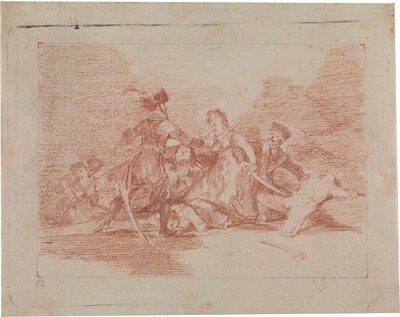- Cronología
- Ca. 1810 - 1812
- Dimensiones
- 165 x 238 mm
- Técnica y soporte
- Etching, aquatint, burin, drypoint and burnisher
- Reconocimiento de la autoría de Goya
- Undisputed work
- Ficha: realización/revisión
- 30 Nov 2010 / 07 Nov 2024
- Inventario
- 225
Goya (lower left-hand corner), 19 (lower left-hand corner, inverted).
See Sad presentiments of what must come to pass.
In the second state proof, the skirt and the shoulder of the woman in the centre were retouched. The faces of the women in the centre were reworked with drypoint and the etching on the other figures was emphasized in burin.
The title was handwritten by Goya on the first and only print run that we know to have been made at the time, and which the painter gave to his friend Agustín Ceán Bermúdez. The title was engraved on to the copperplate at a later date, and no other modifications were made to the image for the first edition of the Disasters of War, which was printed by the Royal Academy of Fine Arts of San Fernando, Madrid, in 1863.
We can see how a correction was made to the title, adding the letter ‘y' where an ‘i' had probably been engraved initially.
There is a preparatory drawing in the Prado Museum.
A group of Mamluk soldiers has caught a group of Spaniards by surprise. One of these has been killed whilst trying to defend the women accompanying them. Another Spaniard is about to be murdered with a sword, but the woman in the centre of the composition has grabbed hold of the Mamluk's hand in an attempt to stop him. In this same moment, the woman faces another of the attackers, his back to the viewer, whilst the woman next to her, who is somewhat older, has put her hands together to beg for mercy. In the background, another woman has been seized by a third Turkish soldier. But whatever he had planned for her will no longer occur, since the Mamluk who has his back turned to us is raising his hands as if to say, just as in the etching's title, "There is no more time". Something has forced the Turkish soldiers to leave.
On this occasion, the women appear to have been lucky and to have escaped the brutal violence to which women are subjected in so many other etchings in the Disasters of War series.
The etching plate is conserved in the National Chalcography Museum (cat. 270)
-
Goya. Das Zeitalter der Revolucionen. Kunst um 1800 (1980 – 1981)Hamburger KunsthalleHamburg1980cat. 77
-
Francisco de GoyaMuseo d'Arte ModernaLugano1996exhibition celebrated from September 22nd to November 17th.cat. 19
-
Francisco Goya. Sein leben im spiegel der graphik. Fuendetodos 1746-1828 Bordeaux. 1746-1996Galerie KornfeldBern1996from November 21st 1996 to January 1997cat. 107
-
Ydioma universal: Goya en la Biblioteca NacionalBiblioteca NacionalMadrid1996from September 19th to December 15th 1996cat. 214
-
Francisco Goya. Capricci, follie e disastri della guerraSan Donato Milanese2000Opere grafiche della Fondazione Antonio Mazzottacat. 99
-
Goya. Opera graficaPinacoteca del Castello di San GiorgioLegnano2006exhibition celebrated from December 16th 2006 to April 1st 2007p. 60
-
Goya et la modernitéPinacothèque de ParisParís2013from October 11st 2013 to March 16th 2014cat. 58
-
2022
-
Goya, grabadorMadridBlass S.A.1918cat. 121
-
Goya engravings and lithographs, vol. I y II.OxfordBruno Cassirer1964cat. 139
-
Vie et ouvre de Francisco de GoyaParísOffice du livre1970cat. 1022
-
Catálogo de las estampas de Goya en la Biblioteca NacionalMadridMinisterio de Educación y Cultura, Biblioteca Nacional1996cat. 215
-
ParísPinacoteca de París2013p. 129
-
Goya. In the Norton Simon MuseumPasadenaNorton Simon Museum2016pp. 114-151
-
Museo de Bellas Artes de Badajoz y Diputación de Badajoz2022p. 61

